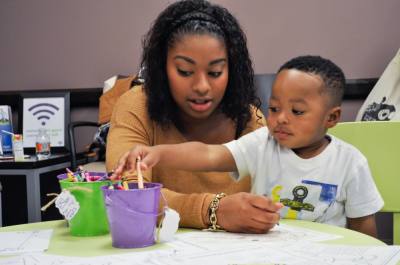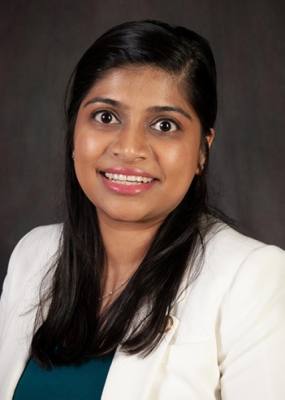Due to their developing anatomy, children are more prone to ear, nose, and throat issues. The first line of defense are their pediatricians, and when problems arise at Austin Regional Clinic, an Ear, Nose & Throat Specialist in the system is ready to help solve them.
As a multi-specialty group with 34 locations throughout Central Texas, ARC offers “connected care” to patients, which means referrals within the group can be made easily. Patient information is accessed through ARC’s electronic medical record system and discussed under one roof.
“Since we [have] connected communication between physicians, it’s so much easier if a pediatrician is concerned about something,” said Dr. Palak B. Patel, an ENT specialist at ARC Round Rock. “ ... I can shoot colleagues a quick question, it’s a quick back and forth. So you get ENT care, but you really get comprehensive medical care.”
One of the most common ENT issues among children is ear infections, or excess fluid in the ear for an extended period. If a child experiences these, ear tubes are inserted to help resolve resulting complications.
“[Ear tubes] is actually one of the most common procedures done by an ENT, but also one of the most common procedures across all surgical specialties,” Dr. Patel said.
Children also have prominent adenoids, which is tissue in the back of the nose. Later in life, adenoids shrink away and get reabsorbed by the body. Before then, adenoids can block the back of the nose and cause issues.
“Because of that, kids will tend to have more nasal obstruction and can also have issues like large tonsils that can affect their sleep,” Dr. Patel said. “ ... The inside of their nose is smaller and as a result, even a little bit of congestion can make them a lot more susceptible to getting ear infections. Just simple colds can turn into sinus infections that seem to linger.”
Dr. Patel said treating children with ENT issues is unique because their smaller anatomy and physiology requires different treatment. ARC doctors take a specialized approach with young people not only to best fit their needs, but also to provide comfort and peace of mind.
“I think talking to them, just addressing them directly versus addressing the parents and speaking to the parents, I’ve noticed has made a huge difference,” Dr. Patel said. “Just talking them through the steps of what we’re about to do, giving them an opportunity to ask questions and answer those questions, puts them at ease.”
In addition to ear and sinus infections, ARC’s expert ENT specialists offer a wide variety of services specially geared toward children and adolescents.
More common conditions they diagnose and treat include:
Hearing impairment
Dr. Patel said she encourages parents who are concerned about their child’s hearing loss to come have their hearing checked at Austin Regional Clinic. Children should be tested if they are not responding to sounds, if there is a family history of hearing loss, or if the child has a history of autism or Down syndrome.
“Testing for hearing loss if a parent is concerned is advised because early development and speech are very much affected by hearing loss,” Dr. Patel said. “Those first few years of life can be very important, and picking up on hearing loss during that time will guide therapy and reduce how much of that hearing loss has an effect on development.”
Frequent nose bleeds
Nose bleeds, or epistaxis, can happen for a variety of reasons. It is common in children because they tend to pick their nose, thus traumatizing the lining of their nose. However, nose bleeds can also indicate more serious issues.
“If there’s a nose bleed, you should always see an ENT. Get it taken care of to make sure none of the more serious issues exist,” Dr. Patel said.
Tongue tie and latching issues
Babies are sometimes born with tongue ties, meaning their tongue is tightly tethered to the floor of their mouth. It prevents them from sticking their tongue out and latching to their mother efficiently, and it can be painful for the mother.
“If you bring them early, usually kids don’t require going to the operating room and they do really well,” Dr. Patel said. “They’ll cry a little bit when I’m treating them, but as soon as they are outside the clinic, they’ve probably already forgotten about it.”
Sinusitis
Children are born with only two of the four sinuses, and the remainder develop in teenage years. Dr. Patel said repeated sinus infections are usually an indicator that something else is awry. Reasons could include an immune system deficiency, allergies or a blockage in the nose.
“It’s unusual for kids to get sinus infections,” Dr. Patel said. “When they do, kids will sometimes have complications such as infection around their eye, and those kids may require sinus surgery.”
Allergies
ENT specialists can also help children with allergies. They help solve the underlying issues by treating inflammation, swelling and congestion as well as addressing the structural problems.
“I make more room inside the nose if we need to,”Dr. Patel said. “Then, the allergist and immunologist is right down the hallway helping with the allergy treatment to also control the congestion and the sneezing and reactivity to all the environmental factors.”
As needed, ARC ENT surgeons perform pediatric surgical procedures at outpatient surgery centers, Dell Children's Medical Center, Strictly Pediatric Surgery Center, and other major hospitals in Central Texas. These operations are typically same-day procedures that involve simple post-operative instructions and do not require hospitalization.
Ready to book an appointment or learn more about Austin Regional Clinic? Visit its website at www.austinregionalclinic.com to find a doctor and nearby location.
The above story was produced by Morgan O’Neal with Community Impact's Storytelling team with information solely provided by the local business as part of their "sponsored content" purchase through our advertising team. Our integrity promise to our readers is to clearly identify all CI Storytelling posts so they are separate from the content decided upon, researched and written by our journalism department.
Select your community
Support Us
News
- Austin Metro
-
Houston Metro
- Houston Metro Home
- Bay Area
- Bellaire | Meyerland | West University
- Conroe | Montgomery
- Cy-Fair | Jersey Village
- Cypress
- Heights | River Oaks | Montrose
- Katy | Fulshear
- Lake Houston | Humble | Kingwood
- New Caney | Porter
- Pearland | Friendswood | Manvel
- Spring | Klein
- Sugar Land | Missouri City
- The Woodlands
- Tomball | Magnolia
- Dallas | Fort Worth Metro
- San Antonio Metro











